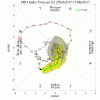Webber, there is correlation with the solar activity and the weather patterns here on Earth. My motivation of the study was to find rather ice ages occur during long duration of solar minimums. In fact they do, you know there was a mini ice age during the years 1650 and 1715 right? There was a solar minimum during those years, the minimum was called the Maunder Minimum. Yes, when I was doing my study, I did record notes in a notepad. From my study, it takes it 5-6 years for to reach the lowest solar minimum from the 11 year peak of the maximum. Then after the solar minimum, the sun starts to trend back to it's maximum and it reaches it's peak in 10-11 years. Sun spots migrate to the equator from the sun from the higher latitudes in about 11 years. As this process is occurring, the sun is going into the solar minimum as the 11 years count down. The data I observed was from a 30 year chart that showed the solar variations of minimums and maximums, that's how I came up with my answers. I believe that when there are solar maximums it warms the upper mantel of the Earth though currents known as field aligned currents and Pederson currents from sun flares that blast though space. The last lowest solar minimum was from 2009-2014, (that's one of the reason's why those winters were cold, especially winter in 2010 and 2014) but as I stated above, it starts to trend back to a maximum after the 5th-6th years from the lowest peak of minimum. I'm not making this stuff up, I really do research.
There's a relationship, but you really didn't find anything convincing...
"Sun spots migrate to the equator from the sun from the higher latitudes in about 11 years. As this process is occurring, the sun is going into the solar minimum as the 11 years count down. The data I observed was from a 30 year chart that showed the solar variations of minimums and maximums, that's how I came up with my answers."
First of all, Don, most scientists are already well aware of the 11-year Hale Cycle, you're not doing any ground breaking work there.
"you know there was a mini ice age during the years 1650 and 1715 right? There was a solar minimum during those years, the minimum was called the Maunder Minimum."
So you only chose one event (the little ice age) to establish this relationship? Yea, that's not going to cut it... You need more samples (at least 30-40 +) to begin to acquire statistical significance.
"Yes, when I was doing my study, I did record notes in a notepad."
Again, there's nothing terribly amazing about this either, literally anybody can take notes in a notebook... That doesn't qualify as a rigorous analysis, at least the kind that I would expect given the kind of data you're working with...
"I believe that when there are solar maximums it warms the upper mantel of the Earth though currents known as field aligned currents and Pederson currents from sun flares that blast though space."
I honestly don't understand what you're talking about here... Aside from the egregious spelling errors, if you're actually going to come up w/ a legitimate theory and not get laughed at by the rest of the scientific community, "I believe ____" doesn't cut it wrt establishing physical mechanisms. You actually need to perform a
multitude of studies, analysis, and they have to be verifiable and reproducible...
Again, you didn't real come up with a "theory", at best this is a poorly misconstrued hypothesis...
Scientific Theory- "... a well-substantiated explanation of some aspect of the natural world, based on
a body of facts that have been repeatedly confirmed through observation and experiment"
I'll ask again what dataset did you use, what papers did you reference, what were their conclusions, etc. because I don't see any of those in your response.

